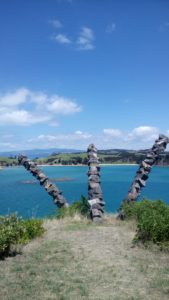Posts Tagged ‘tourism new zealand’
NZx: February 10th Manaakitanga in the C21
Naumai
Is this really the best manaakitanga we can offer?
Tourism New Zealand suggests: the meaning of manaakitanga is much broader than a one word or direct translation.
It can be broken down into three parts: mana-ā-ki which loosely translates as ‘the power of the word’ and reminds hosts to be expressive and fluent in welcoming visitors.
Another explanation has the words mana / prestige and ki te tangata / to the people – pointing out the importance of enhancing the mana which covers the integrity, status / prestige, and power of guests.
Here, as our experience suggests, a great day out was left wanting in manaakitanga by our introduction to Fullers ferry and the introduction by staff on arrival at Rotoroa Island.
Our manaakitanga component started off by having to queue for the ferry. No big deal but despite being early morning it was a burning , windless day. People who had queued early inside the perspex cover were eventually forced to abandon their place in line and escape the hot tapped air. It was seriously stifling.
There was general confusion about who was queuing for what. Was this the ferry to Rangitoto, Tiritiri Matangi or Rotoroa Island? No signs, or technology, not even temporary, just two staff that came and went answering the same questions as to the destination.
Two minutes after leaving the wharf we returned – someone had got on the wrong ferry……. That’s despite a handheld scanner that supposedly scanned everybody aboard including our mobile phone downloaded tickets. Only problem was it couldn’t read the bar code on our phone!
On arrival all seventy plus of us were crammed into a small hot shed on the wharf and given a rambling presentation about the history, issues and do’s and dont’s on the Island. We fully support the bio-security intent behind this – but having endured countless windblown ( you can’t here the words and often the speakers aren’t great) welcomes at Tiritiri Matangi and other DOC/partner managed islands, one has to wonder is there a better way? It is human nature to not what to be confined (see Maslow) and to be acknowledged and treated with intelligence. This and other Island welcomes don’t do this! DOC and it’s partners should use other ways of pushing the bio-security message to what is mostly an already knowledgeable audience.
The final straw was when the ranger announced a different ferry departure time back to Auckland than that advertised in the various Fullers media. Normally extra time on an Island such as Rotoroa would be great, but we had organised a busy late afternoon around the quoted departure time and arrival back in Auckland.
The last comment the ranger made before “releasing us” was to invite us back inside the shed before we got on the return ferry – surely not!
In the end it was with much thankfulness that the staff on Rotoroa didn’t invite us back into the hot little shed on the wharf to say haere ra! Everyone was far too busy enjoying the sunshine, swimming off the wharf an enjoying their last minutes on the Island.
Rotoroa Island is a fantastic day out. But two of the key partners need to up their game in the manaakitanga stakes. The basic mana of visitors just isn’t being respected.
Ka kite ano

